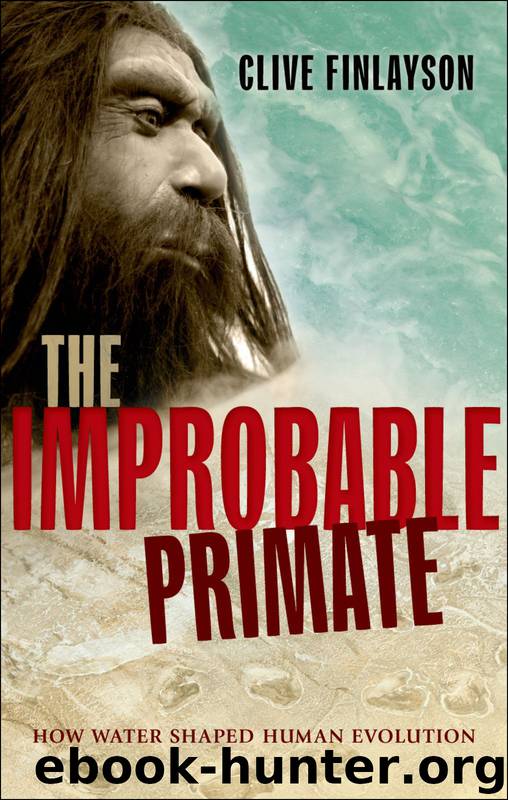The Improbable Primate by Finlayson Clive

Author:Finlayson, Clive
Language: eng
Format: epub
Publisher: OUP Oxford
Published: 2014-02-13T05:00:00+00:00
8
The Exceptional World of the Neanderthal
400–30 THOUSAND YEARS AGO
As Homo sapiens sapiens—the lineage of southern Middle Earth—was starting to feel the pinch after 450 thousand years ago, a separate lineage had embarked on its own particular adventure in the non-tropical regions of Eurasia. That lineage had a common ancestor with sapiens, which genetic work has put at around 400 thousand years ago.1 This Eurasian lineage is often referred to as Homo heidelbergensis, the same name that is applied to the African lineage of Homo sapiens from the same period and which was the subject of Chapter 7. Others, as mentioned earlier, distinguish the African and Eurasian lineages, giving the name rhodesiensis to the Africans and retaining heidelbergensis for the Eurasian contingent. The nomenclature has clouded the continuous evolutionary process. At one end of the scale some authors have tried to make each regional version of heidelbergensis into a species in its own right and at the other end they have merged them into one. When considering fossils that show some characteristics typical of the Neanderthals, some authors refer to these as heidelbergensis while others talk of pre-Neanderthals, a term that reminds me of ‘archaic modern human’ and reveals the inadequacy of trying to put a continuous evolutionary process in a straitjacket. Since this lineage led to the Neanderthals but was derived from the common sapiens ancestor, I shall refer to it as Homo sapiens neanderthalensis. For our purposes they are the Neanderthals, even if the earliest ones do not have all the features that have been defined as characteristic of them.
The Neanderthals lived across Eurasia but we cannot determine where they originated with exactitude, although the common but unsupported view is that it was in western Europe.2 At the height of their success, their range extended from the Iberian Peninsula in the west right across to central Siberia, and probably beyond, in the east.3 The achievement of the Neanderthals should not be underestimated and it matches that of humans in the drying world of southern Middle Earth. In Chapter 6 we saw how humans had struggled to survive on the northern edge of their range, in Europe, central Asia, and China. Occupation of northern territories was not permanent and populations were pegged back during cold periods. If that was bad, imagine what followed after 450 thousand years ago. The conditions that brought severe drought to Africa also brought extreme cold to Eurasia.
The Neanderthals, like their predecessors, could only survive in warm and humid refuges each time that the ice set off on a southerly excursion. The coastal south-westernmost tip of the Iberian Peninsula between Gibraltar and Lisbon, the mildest and least arid part of Europe, was their main stronghold. The limit of their geographical range was marked in the south by the Mediterranean Sea and its high mountains. High mountains ran from there across Middle Earth, all the way to China. They were formidable barriers which were impenetrable at the best of times, let alone during a glaciation when ice descended from the lofty heights.
Download
This site does not store any files on its server. We only index and link to content provided by other sites. Please contact the content providers to delete copyright contents if any and email us, we'll remove relevant links or contents immediately.
Man-made Catastrophes and Risk Information Concealment by Dmitry Chernov & Didier Sornette(5951)
The Revenge of Geography: What the Map Tells Us About Coming Conflicts and the Battle Against Fate by Kaplan Robert D(4052)
Zero Waste Home by Bea Johnson(3804)
COSMOS by Carl Sagan(3586)
Good by S. Walden(3518)
In a Sunburned Country by Bill Bryson(3506)
The Fate of Rome: Climate, Disease, and the End of an Empire (The Princeton History of the Ancient World) by Kyle Harper(3030)
A Wilder Time by William E. Glassley(2833)
Camino Island by John Grisham(2778)
Organic Mushroom Farming and Mycoremediation by Tradd Cotter(2660)
The Ogre by Doug Scott(2657)
Human Dynamics Research in Smart and Connected Communities by Shih-Lung Shaw & Daniel Sui(2479)
Energy Myths and Realities by Vaclav Smil(2463)
The Traveler's Gift by Andy Andrews(2435)
9781803241661-PYTHON FOR ARCGIS PRO by Unknown(2342)
Inside the Middle East by Avi Melamed(2325)
Birds of New Guinea by Pratt Thane K.; Beehler Bruce M.; Anderton John C(2236)
A History of Warfare by John Keegan(2210)
And the Band Played On by Randy Shilts(2163)
